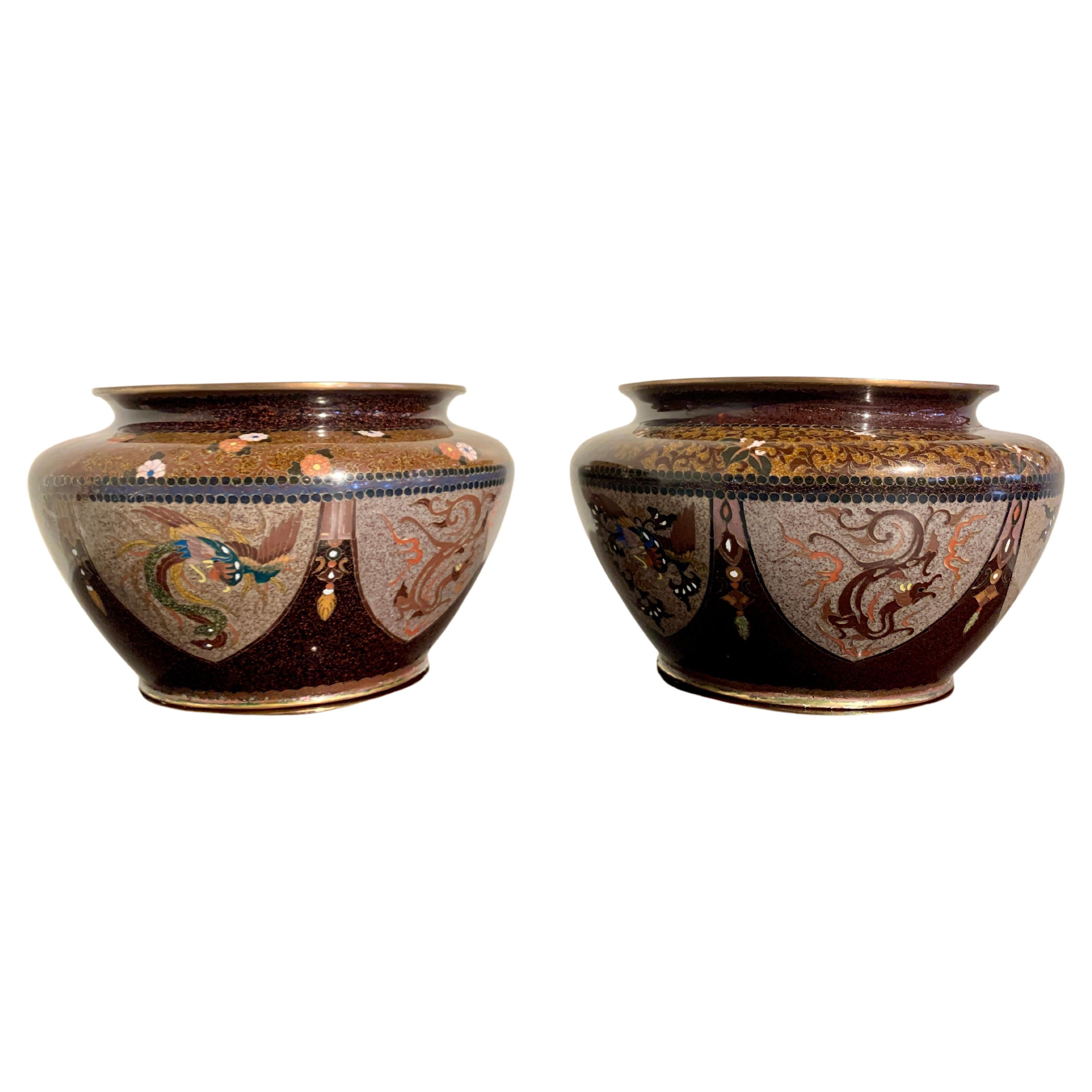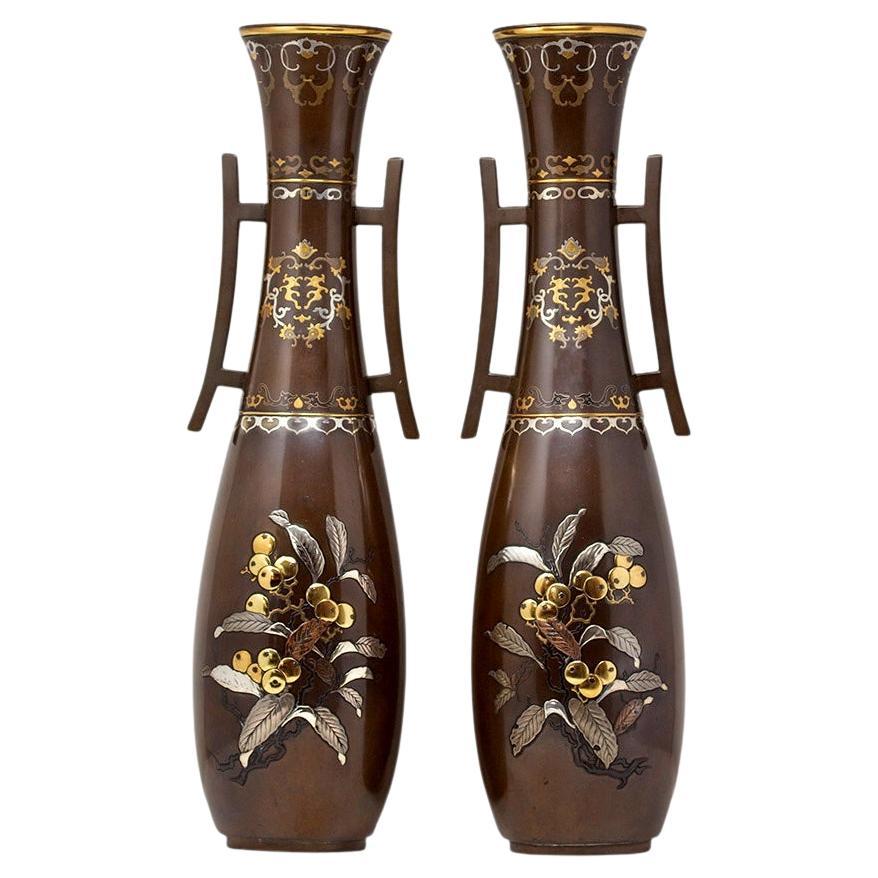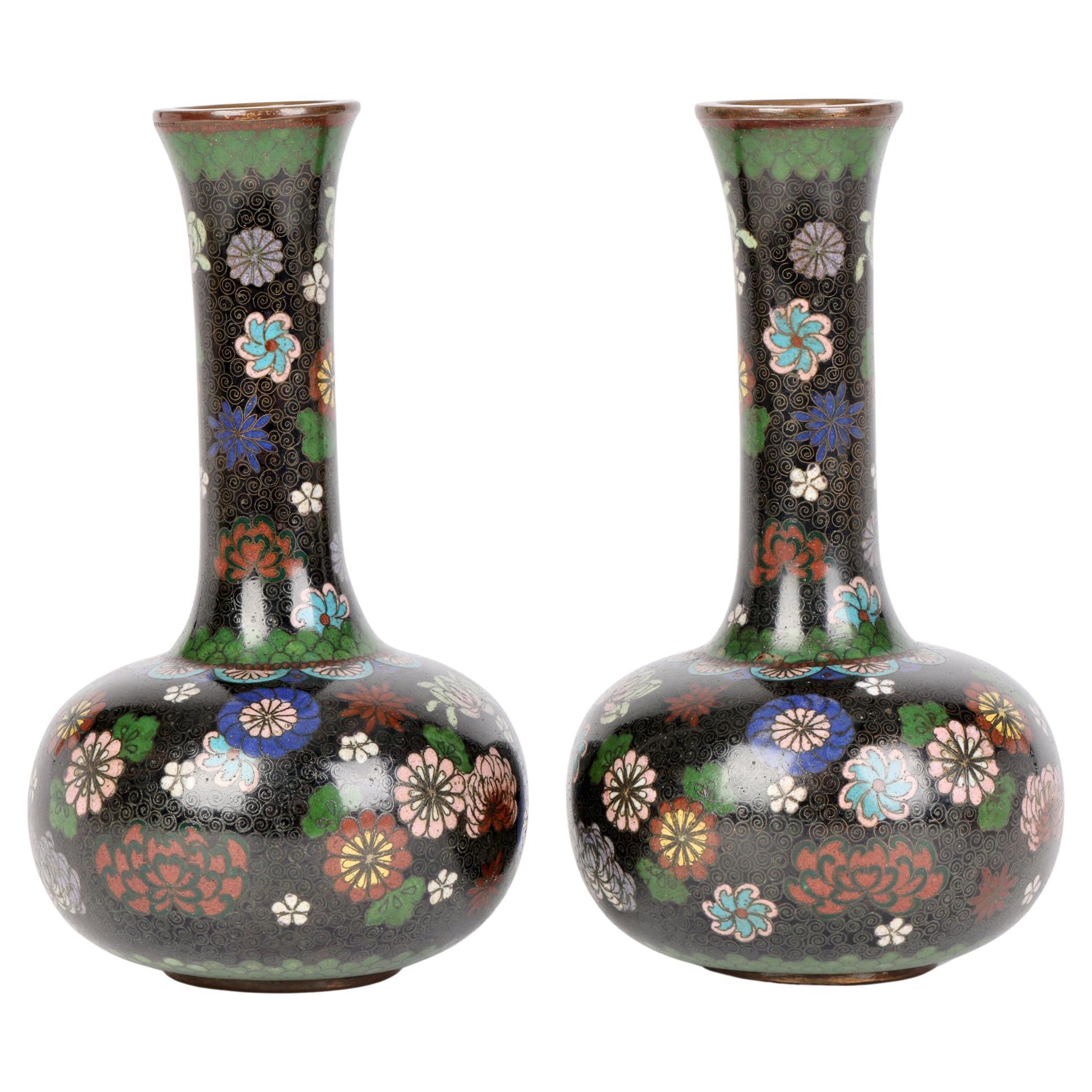Items Similar to Ota Jinnoei 1890 Imperial Meiji Period Pair of Cloisonne Cabinet Vases
Want more images or videos?
Request additional images or videos from the seller
1 of 5
Ota Jinnoei 1890 Imperial Meiji Period Pair of Cloisonne Cabinet Vases
About the Item
Pair of cloisonne vases designed by Ota Jinnoei.
Beautiful pair of small cabinet vases, created in Japan circa 1890, during the meiji Imperial period (1868-1912). These vases has been carefully crafted at the atelier of the cloisonne master Ota Jinnoei. Made in silvered bronze with applications of high polished cloisonne enamel, worked in silver wire and decorated with organic motifs of flowers trees and little birds.
Weight: 73.75 Grams, (47.27 Dwt).
Measurements: 89 mm by 50.8 mm (3.5 x 2 Inches).
Hallmarks: Both are stamped under the base with the maker's mark monogram associated to Ota Jinnoei.
Meiji period, is an era of Japanese history that extended from October 23, 1868 to July 30, 1912.The Meiji era was the first half of the Empire of Japan, when the Japanese people moved from being an isolated feudal society at risk of colonization by Western powers to the new paradigm of a modern, industrialized nation state and emergent great power, influenced by Western scientific, technological, philosophical, political, legal, and aesthetic ideas. As a result of such wholesale adoption of radically different ideas, the changes to Japan were profound, and affected its social structure, internal politics, economy, military, and foreign relations. The period corresponded to the reign of Emperor Meiji. It was preceded by the Keio era and was succeeded by the Taisho era, upon the accession of Emperor Taisho.
Cloisonné is an enamelling technique in which the pattern is formed by wires soldered to the surface of the object to be decorated, which is usually made from copper, forming cells or cloisons, each of which holds a single colour of enamel paste which is then fired, and ground and polished. The champleve technique also uses an enamelling technique, but the cells are formed by carving into the surface ot the object, or in the casting. The cloisonne technique has been in use since the 12th century BC in the west, but the technique did not reach China until the 13th or 14th century. It became popular in China in the 18th century. Initially bronze or brass bodies were used, and in the 19th century copper, at which time the quality of th eitems produced began to decline. Chinese cloisonné is the best known enamel cloisonné, though the Japanese produced large quantities from the mid-19th century, of very high technical quality. In the west the cloisonne technique was revived in the mid 19th century following imports from China, and its use continued in the Art Nouveau and Art Deco periods.
Collections: Victoria & Albert Museum, London United Kingdom Auckland Museum, Auckland New Zealand.
Collateral: They are accompanied by a presentation box.
Condition: The overall condition of this pair of vases is excellent. Beside the little normal wear, there is absolutely no damage These pieces has been carefully inspected to guarantee the condition and authenticity.
INVENTORY REF: D110822TENK/2.361
- Creator:Ota Jinnoei (Maker, Designer)
- Dimensions:Height: 3.5 in (8.89 cm)Width: 2 in (5.08 cm)Depth: 2 in (5.08 cm)
- Sold As:Set of 2
- Style:Meiji (Of the Period)
- Materials and Techniques:
- Place of Origin:
- Period:
- Date of Manufacture:1890
- Condition:Wear consistent with age and use. The overall condition of this pair of vases is excellent. Beside the little normal wear, there is absolutely no damage These pieces has been carefully inspected to guarantee the condition and authenticity.
- Seller Location:Miami, FL
- Reference Number:
About the Seller
5.0
Platinum Seller
These expertly vetted sellers are 1stDibs' most experienced sellers and are rated highest by our customers.
1stDibs seller since 2023
63 sales on 1stDibs
Typical response time: <1 hour
- ShippingRetrieving quote...Ships From: Miami, FL
- Return PolicyA return for this item may be initiated within 1 day of delivery.
More From This SellerView All
- Japan 1890 Meiji Period Bronze Koro Censer in Cloisonne Enamel with Jade LidLocated in Miami, FLJapanese Koro from the Meiji Period (1868-1912). Beautiful antique ten sides fluted koro censer, created in Japan during the Meiji period (1868-1912), ci...Category
Antique 1890s Japanese Meiji Metalwork
MaterialsJade, Gold, Silver, Bronze, Enamel
- Japan 1890 Meiji Period Decorative Vase In Cloisonné Enamel With Wood BaseLocated in Miami, FLJapanese vase from the Meiji Period (1868-1912). Beautiful antique decorative vase, created in Japan during the Meiji period (1868-1912), circa 1890s. It was carefully crafted in so...Category
Antique 1890s Japanese Meiji Metalwork
MaterialsBronze, Enamel
- Japan 1900 Meiji Period Charger With A Dragon In Cloisonné Multicolor EnamelLocated in Miami, FLLarge charger in cloisonné from imperial Japan. Beautiful piece of Japanese decorative arts, created during the Meiji imperial period, circa ...Category
Antique Early 1900s Japanese Meiji Metalwork
MaterialsBronze, Copper, Enamel
- China 960 Ad Song Dynasty Very Rare Imperial Period Offering Vessel in BronzeLocated in Miami, FLOffering vessel from the Chinese Song Dynasty (960/1279 AD ). A beautiful "offering spiritual vessel" from the Yunnan province region in the ancient China. This rare vessel was created in red bronze during the Song Dynasty period. between 960/1279 AD. This is one of the most unusual forms of red bronze jar. A large vessel, the sides are virtually perpendicular to the base. The stepped lid design is also among the more rare types. The predominant lid design among the Yunnan offering bronzes is the "wheel" pattern, with a few lids having the lotus design. This is also one of the few bronzes displaying clear riveting of a two-part vessel body, with the original twisted elements Has a combined measures including the lid of 12.5 by 8.75 inches (31.75 x 22,23 Cm). The Song Dynasty, was an imperial dynasty of China that began in 960 and lasted until 1279. The dynasty was founded by Emperor Tizu of Song following his usurpation of the throne of the later Zhou, ending the Five-Dynasties and Ten Kingdoms period. The Song often came into conflict with the contemporaneous Liao, Western Xia and Jin dynasties in northern China. After decades of armed resistance defending southern China, it was eventually conquered by the Mongol-led Yuan dynasty. The dynasty is divided into two periods: Northern Song and Southern Song...Category
Antique 15th Century and Earlier Chinese Medieval Antiquities
MaterialsBronze
- Japan Meiji 1900 Three Bronze Ducks Sculpture in Wood Stand and CoralLocated in Miami, FLSculptural composition of the ducks from the Japanese Meiji Period. Beautiful and very well realized sculptural composition of three ducks, made during the japanese imperial perio...Category
Antique Early 1900s Japanese Meiji Sculptures and Carvings
MaterialsCoral, Bronze
- Ando Jubei Japan 1950 Showa Period Cloisonné Enamel Green Bombe VaseBy Ando JubeiLocated in Miami, FLCloisonné enamel vase designed by Ando Jubei. Beautiful piece of Japanese decorative arts, created by the Ando Jubei Company during the Showa...Category
Vintage 1950s Japanese Showa Vases
MaterialsSilver, Enamel
You May Also Like
- Late Meiji Period Cloisonné VaseLocated in New York, NYJapanese vase with enamel cloisonné depicting naturalistic scenes with birds on one side and with fish on the other from the late Meiji period, circa...Category
Antique Early 1900s Japanese Meiji Metalwork
MaterialsMetal, Enamel
- Japanese Cloisonne Enamel Vase Pair Meiji PeriodLocated in Newark, EnglandA sensational pair of Japanese Meiji period Cloisonne enamel bottle vases. The vases of slender hexagonal form with trumpet opening upon a circular foot. Decorated to the highest qua...Category
Antique Late 19th Century Japanese Meiji Metalwork
MaterialsMetal, Silver
- Pair Japanese Cloisonne Dragon and Phoenix Jardinieres, Meiji PeriodLocated in Austin, TXA lovely pair of Japanese chakinseki, tea dust, cloisonne jardinieres, Meiji Period, circa 1900, Japan. The jardinieres each with a squat globular body, short neck, and wide, everted mouth. The bodies decorated wide lappets of mottled puce featuring alternating dragons and phoenixes...Category
Antique Early 1900s Japanese Meiji Planters, Cachepots and Jardinières
MaterialsCopper, Enamel
- Japanese Bronze Vase Pair Meiji PeriodLocated in Newark, EnglandA fine large sized pair of Japanese bronze vases. The vases each surmounted by waisted necks flanked by two spreading handles with accents in the form of Japanese Torri (traditional ...Category
Antique Late 19th Century Japanese Meiji Metalwork
MaterialsMetal, Gold, Silver, Bronze, Copper
- Japanese Pair Meiji Cloisonne Bottle Vases with Scattered Floral DesignsLocated in Bishop's Stortford, HertfordshireA fine pair Japanese Meiji period cloisonne bottle shaped vases decorated with scattered floral patterns and dating between 1868 and 1912. The vases are lightly made standing on a fl...Category
Antique 19th Century Japanese Meiji Metalwork
MaterialsBrass
- Japanese Art Nouveau Cloisonne and Ginbari Amphora Vase, Meiji Period, JapanLocated in Austin, TXAn unusual and elegant Japanese Art Nouveau amphora shaped cloisonne and ginbari foiled vase, Meiji Period, circa 1900, Japan. The vase of amphora form, with a tapering body resti...Category
Antique Early 1900s Japanese Art Nouveau Metalwork
MaterialsCopper, Enamel, Foil, Wire
Recently Viewed
View AllMore Ways To Browse
Asian Influence Furniture
Modern 1890
1890 Japan
Japanese Emperor
Emperor Japan
Polished Presentation
Imperial Mid
Antique China Makers Marks
Imperial Japan
Japanese Imperial
Meiji Pair
Pair Military
Mid Century Asian Influence
Art Flower Maker
Imperial Flowers
Pair Of Emperor
Antique Furniture West London
Imperial Enamel





